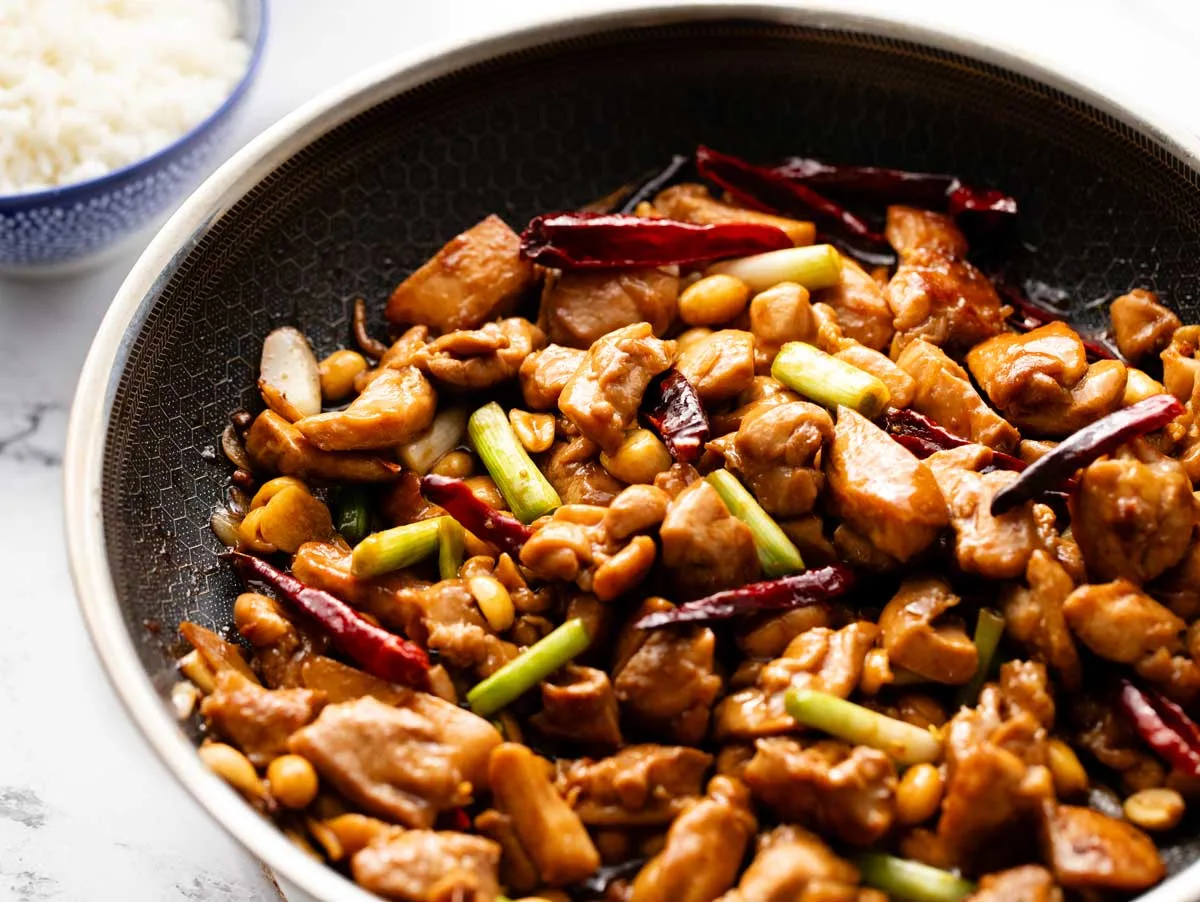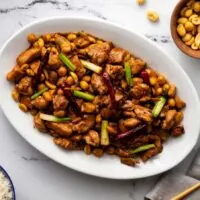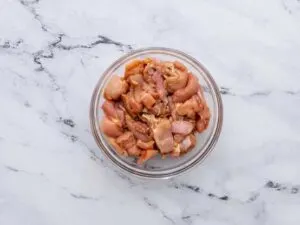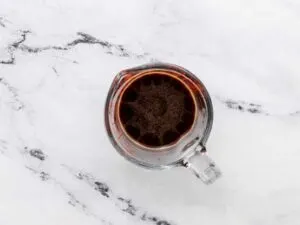This recipe was created for the home cook who wants to step out of their comfort zone to create a restaurant quality Kung Pao chicken dish. While most of the ingredients in this dish are easily found in major supermarkets, Sichuan peppercorns and dried Sichuan chiles may require a visit to a specialty market (or bought online). These are necessary for an authentic restaurant-quality dish.

So, what sets this recipe apart from a basic stir-fry? The combination of a few authentic Sichuan ingredients, combined with the technique of “velveting the chicken” are what makes this recipe stand out. The resulting flavor is not just hot and spicy. Instead, it is sweet, tangy, rich, and savory with a hint of spicy that leaves your tongue tingling.
The lemony flavor of Sichuan peppercorns is similar to lemongrass and also adds a tongue-numbing effect which we so often crave.
Kung Pao chicken has several regional variations. The staple ingredients of the original recipe consists of peanuts, chiles, and scallions (or green onions). You can add one cup of any chopped vegetable you prefer to make it your own. We like adding crunchy bell peppers and celery.
Tip: The key to the success of this recipe is preparing all your ingredients first, as this dish cooks up very fast.
Substitutions and variations
- Sichuan peppercorns – Unfortunately, there is no comparable substitute for the Sichuan peppercorns in this recipe. When this ingredient is omitted, you will still have a delicious and flavorful meal. However, if you want to see what a classic Kung Pao tastes like, they are a necessity. But the good news? They are easy to find on Amazon or your local Asian market.
- Dried Sichuan peppers – Swap the same amount with chili de arbol or add red pepper flakes for a touch of spicy heat.
- Proteins – Chicken, pork, or tofu will work well in this recipe. These are proteins that absorb marinades very well. Avoid beef and shrimp as the result will not be the same.
- Nuts – Peanuts are original to the dish but cashew nuts will also work very well.
- Veggies – Crunchy vegetables that are sturdy even when cooked like celery, bell peppers, bamboo, and water chestnuts are ideal for Kung Pao chicken.
- Oil – Try to use the oil with the highest smoke point you can find like vegetable oil or peanut oil. Add a touch of sesame oil to provide a nice flavor to your dish.

Recipe tips and FAQ
- This is a very hands-on recipe. Prepping the ingredients ahead of time will yield the best results.
- This recipe also calls for managing the heat as you cook. Gas stoves will cook a little differently than electric. Even the cooking pan you use will have an impact on how the heat is distributed. For the best results, rely on your senses rather than strictly adhering to the suggested cooking times. Pay close attention to visual cues and the aroma to determine when to flip, stir, or remove from heat.
- “Velveting the chicken” is a technique applicable to any protein when stir-frying. It involves incorporating cornstarch into the marinade before cooking, allowing the carbohydrates to lock in juices and shield the protein from high heat for improved heat distribution. While stir-frying without cornstarch is possible, adopting this velveting technique enhances the dish’s restaurant-level quality.
- When prepping the dried Sichuan chilies, be mindful of the heat. Just like fresh chilies, the heat resides inside the chiles. To mellow out the heat, simply snip the top off of the chili with scissors and pour out the seeds. If you like it extra-spicy, cut the peppers in half and use the seeds in the cooking process.

Is Kung Pao Chicken spicy?
No. In fact, classic Kung Pao chicken has several regional versions. But overall, Kung Pao chicken is described as having a savory, sour, sweet flavor, with just a hint of spice.
How do Chinese make their chicken so tender?
As stated in the recipe, “velveting the chicken” is a technique used to make chicken more tender in dishes such as this one. Using cornstarch in the marinade (before cooking) helps seal in the juices and shields the chicken from the high heat of the pan.
How long can I store the leftovers?
Place leftovers in an airtight container in the refrigerator. They will stay fresh for about 3 days. Fully reheat in the microwave or on the stovetop.
Can you freeze this Kung Pao Chicken?
You can freeze this Kung Pao chicken. Reheat on the stove over medium heat, stirring constantly. Or, reheat in the microwave or slow cooker. Thaw the frozen Kung Pao chicken and place in your slow cooker on low for 3 hours, or on high for 1 hour.
What is the difference between Kung Pao chicken and General Tso’s chicken?
These two dishes are very different in their preparation. General Tso’s chicken consists of deep-fried chicken pieces and is often coated in a sauce that is sweet-and-sour style.
What does authentic Kung Pao chicken taste like?
Authentic Kung Pao chicken is savory, slightly sour and a little bit sweet. The flavors of Sichuan peppercorns come through and leave a slightly numb feeling on the tongue. Crunchy peanuts bring the recipe together for an irresistible texture. It’s one of our favorite dishes!
The next time you’re craving Chinese takeout, try making this authentic Kung Pao recipe at home. While the extensive list of ingredients may seem intimidating, most of the work is done before the cooking process. This recipe will make you feel like professional chef. You’ll be glad you have the leftover ingredients on-hand so you can make this recipe again and again.

Best Kung Pao Chicken (Authentic Recipe)
Ingredients
Chicken marinade
- 1.5 lbs boneless, skinless chicken thighs cut into small cubes
- 1 Tbsp. soy sauce
- 2 tsp cornstarch
Kung Pao Sauce
- 1/4 cup water or chicken broth
- 5 Tbsp. soy sauce
- 2 Tbsp. balsamic vinegar
- 2 Tbsp. Chinese Shaoxing wine or dry white wine
- 2 tsp hoisin sauce
- 1 Tbsp. brown sugar
- 1.5 tsp cornstarch
Aromatics
- 1 tsp Sichuan peppercorns chopped coarsely, see notes
- 9 large Sichuan chilis dried, cut lengthwise
- 5 cloves garlic sliced thin
- 2 Tbsp. fresh ginger peeled and cut into matchsticks
Stir-fry
- 5 green onions cut into 1" pieces
- 1/2 cup roasted salted peanuts
- Cooking oil peanut or vegetable
Instructions
Ingredient preparation
- Combine chicken and marinade ingredients in a medium bowl and set aside for 20 minutes.

- In a small bowl, whisk together all of the Kung Pao Sauce ingredients and set aside.

- Prepare your aromatics by course chopping the Sichuan peppercorns, slicing the dried chilies, mincing the garlic, and slicing the ginger. Set aside.
- Chop green onions into 1" pieces and set aside with peanuts.
- Arrange your workstation in this order: Marinated chicken (with extra plate for batch cooking), Sichuan peppercorns, chilis, garlic, ginger, Kung Pao sauce, chopped green onions, and peanuts.
Cooking the chicken
- Pre-heat your pan over medium high heat and add 2 tablespoons of oil. Once it starts to glisten, the pan it is ready.
- Add some of the chicken to the pan in a single layer. After about 2 minutes, flip the chicken to brown the other side. Remove chicken from the pan and replace the oil for the next batch. Repeat until all chicken is cooked. Set aside.

Cooking the aromatics (this part moves quick!)
- Reduce heat to low. Add 2 Tbsp. of oil to the pan and allow about 15 seconds to warm up.
- Add the peppercorns and stir vigorously until fragrant about 30 seconds.

- Add chilis, stirring vigorously until soft, about 30 more seconds.

- Add garlic and ginger and stir for another 30 seconds or until the garlic becomes soft and slightly translucent.

- Raise the temperature to medium and add the Kung Pao sauce. Continue stirring for about 30 seconds, the sauce should bubble and begin to thicken.

Finishing the Kung Pao
- Add chicken and stir until coated. Add green onions and peanuts, stir entire dish for another 30 seconds to combine and heat through.

- Serve warm over cooked white rice or noodles.
Notes
- This is a very hands-on recipe. Proper ingredient preparation (before turning on the stove) will lead to the best outcome. For the best results, rely on your senses rather than strictly adhering to the suggested cooking times. Pay close attention to visual cues and the aroma to determine when to flip, stir, or remove from heat.
- Chicken Marinade: “Velveting the chicken” is commonly used in Chinese cuisine. This technique entails incorporating cornstarch into the marinade before cooking, allowing the carbohydrates to lock in juices and shield the protein from high heat for improved heat distribution.
- Prepping the Sichuan peppercorns: The finer the grind of the peppercorns the more intense and widespread the mouth-numbing sensation will be. Use a sharp butcher knife or coffee grinder, and quick chop them until they are somewhat diced.
- Prepping the dried Sichuan chilies: Just like fresh chilies the heat resides inside the chilies. To mellow out the flavor and spice, simply snip the top off of the chili with scissors and pour out the seeds. If you like spicy, cut the peppers in half and use the seeds in the cooking process.
- Add any fresh produce that holds up well to cooking. We like to add fresh red bell pepper, celery, baby corn, carrots, or water chestnuts.
- If you can’t find dried Sichuan chilies, you can use fresh jalapeño, cayenne, or dried red chili flakes as a substitute. The main goal is to add a mild amount of spice to the dish without overpowering it.

Wesley Workman
Sunday 7th of January 2024
We made this last weekend and it was awesome!! Great way to use some of the extra peppers.
paul boyer
Thursday 14th of December 2023
HI When prepping the dried Sichuan chilies, be mindful of the heat. Just like fresh chilies, the heat resides inside the chiles. To mellow out the heat, simply snip the top off of the chili with scissors and pour out the seeds.
I'm surprised about this statement. Chile seeds are not a source of heat.
Paul Boyer
Friday 22nd of December 2023
@paul boyer, This is an interesting topic. Fresh chiles where the seeds are attached to the placenta could have oil on them when extracted, I agree. But for dried chiles- "snip the top off and pour out the seeds", the seeds are no longer attached to the placenta. So where does the heat come from? Thanks for a reply.
peppergeek
Friday 15th of December 2023
They're attached to the placenta, where most of the heat resides. So by doing this, you'll reduce the heat somewhat.
Sandra
Thursday 14th of December 2023
We loved this recipe. Outstanding! Can not wait to make it again. Hit with the everyone.
Henry Alvarez
Wednesday 13th of December 2023
there should be more stars as every recipe you've given us has turned out great. My wife has a bachelor's degree in Institutional Foods from the University of CA and she was teaching cooks and chefs. When she saw this her eyes lit up and she said, "We'll do it." I can hardly wait. We both love Asian cuisine. Thank you, Hank
peppergeek
Thursday 14th of December 2023
Hank, that is amazing! So happy you've enjoyed our recipes. Thanks for the rating, hope you enjoy the Kung Pao!